Queens are often considered the rulers over all bees in their colony with everything revolving around them and their ability to reproduce. They’re typically the only royal members of their colony, with no rivals.
So, is it ever possible for a colony to have two queens? If so, will they have the same status, or will one of them dominate the other?
Beehives typically have one queen, however, if the queen is not performing the worker bees will create another queen. The time with multiple queens is short-lived. The workers will kill the old queen or there is a fight to the death between the queens, in other cases the old queen will leave the hive with a swarm.
So, as we just discovered there might be two queens in a hive under some conditions. How do they handle this, and who rules the colony then? Read on to learn more.
How Many Queens Are in a Single Beehive?
As mentioned earlier a single hive has only one queen. However, as the queen ages, her ability to lay fertilized eggs will gradually diminish. This also coincides with a reduction in her “footprint pheromone”. This pheromone signal to the worker bees that their queen is present and active. We have a whole article on the topic of Bee Communication. The way bees communicate is actually fascinating.
When the worker bees recognize the queen’s drop in performance they will begin a plan to supersede her to make sure they’ll have a viable queen for the colony into the future.
Worker bees will use one or more fertilized eggs and build queen cells for them. To prepare the eggs for reproduction, the nurse bees feed freshly hatched larvae royal jelly from their hypopharyngeal glands. The nutrient-rich mixture contains protein, carbs, water, and fats.
The worker bees continue to feed the queen bee larvae royal jelly for about 8 to 9 days before the queen cell is sealed for the queen to pupate. About 7 to 8 days later the queen bee will emerge from her queen cell.
Once a queen bee emerges, a showdown is inevitable as the hive may now have two or more queens. Queens that have not emerged are now at risk of being eliminated by a rival queen. Rival queens will chew a hole in the wax queen cell and then sting the queen pupa in her queen cell.
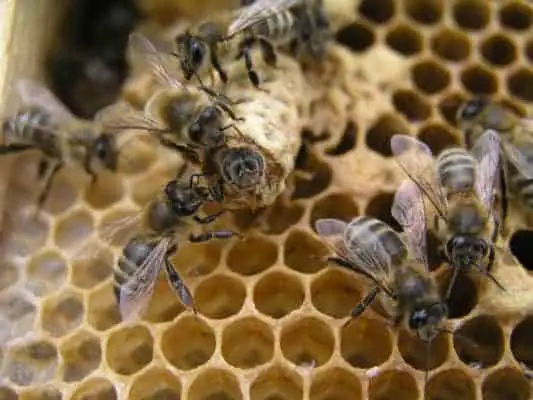
Now one of three thing will occur with the remaining queens in order to bring the hive back to its natural state with only only queen.
1. Fight to the Death
The queens will fight to the death with the victor taking up her position as the sole royal member of the hive.
2. Swarming
The hive will swarm. This is usually a planned exercise by the bees. They do it to free up space in the hive. Usually, the original queen is doing a great job but due to a lack of space worker bees will create new queens to allow the hive to swarm.
Not all swarms will survive. Those that are successful will find a home in a hollow of a tree, or a wall cavity of a building, or really any sheltered space where they can build combs and begin storing resources.
The location they choose is not always convenient for people particularly when the location is in your own house. Removal of the bees can be an involved process. We do have an entire article dedicated to this process, Bee Removal. How It’s Done and Who Can Do It For You.
3. Workers kill the Queen
This happens typically when the queen is old and laying too many unfertilized eggs. The workers will make a new queen once she has emerged and successfully mated the worker will ball around the old queen. This process heats up the queen inevitably causing her death. The dead queen is discarded at the entrance of the hive.
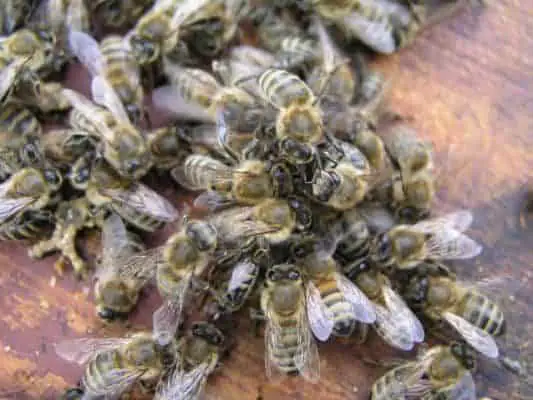
In order to signal to the workers that she is present and actively laying fertilized eggs she releases pheromones. As she ages, the amount of pheromone she releases begins to fade. Signaling to the worker bees that it may be time to supersede her with a new queen.
We cover this in detail in another post called, “How do bees communicate?“. Her pheromones even suppress the development of the reproductive system in worker bees, it’s actually pretty amazing how it all works.
A Colony With More Than One Queen
As we have been through earlier honey bees can have more than one queen for short periods of time before the workers will bring the hive back to its natural state.
In rare cases, there could be more than one queen in the colony for a short period. Sometimes, the egg hatches before the current queen dies. In this case, the daughter and the mother continue to live alongside each other. The young daughter mates and lays eggs. But this cohabitation can’t continue for too long since workers don’t want to have two queens to tend to. That means the queens’ fate isn’t so much decided by themselves as workers.
Over time, the first queen’s ability to lay eggs diminishes. And her pheromones start to lose their strength, indicating that the queen is getting old. When worker bees get these signals, they begin preparing supersedure eggs to replace the queen. When the new queen emerges out of her egg, the two queens can co-exist until the younger one lays eggs.
According to experienced beekeepers, if worker bees decide that the two queens should temporarily live in the same hive, they make sure they don’t kill each other by separating them and keeping them in two different spots in the hive.
However, once the new queen has laid enough eggs, the worker bees may decide to kill off the old queen themselves! This depends on whether they deem the new queen to be a better monarch than the old one. Otherwise, they let the older queen kill the new one.
Another likely scenario is that the old queen takes some of the population and exits the hive to make another colony elsewhere. This process is called swarming.
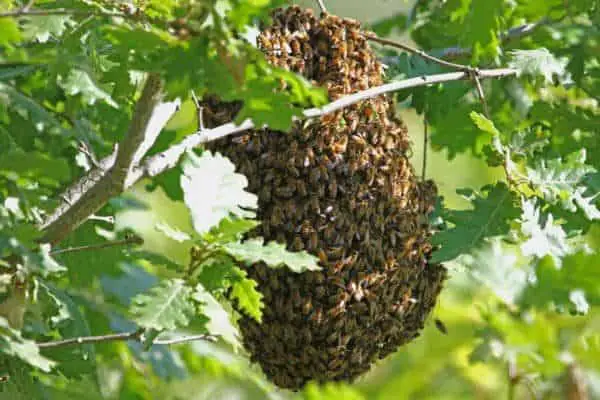
During this process, a group of work bees set out to find a suitable place for the new colony. Until then, the old queen remains in the original hive, cohabiting with her daughter. This is one of those cases when worker bees keep them separated so that they don’t fight. Once the new hive is established, the old queen leaves and some of the working bees accompany her.
Is the Queen the Only Ruler in the Colony?
Although the queen may appear to control the colony through her pheromones, she doesn’t have much authority over it. Her primary role is a reproductive one, laying up to 1500 eggs a day. Her reproductive functions determine the unique position of the queen.
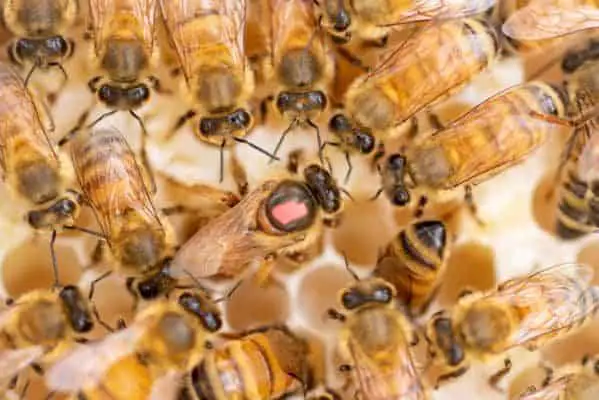
Plus, the colony is more of a democracy, with all worker bees deciding (and somehow voting!) on swarming or selecting which eggs to turn into queens. Scientists haven’t discovered much about the decision-making process and think that it could involve a degree of randomness.
What Happens if a Colony Doesn’t Have a Queen?
Most of the time, when worker bees detect the absence of the queen through pheromones, they quickly start creating emergency cells to make new queens. They choose the worker cells containing larvae less than three days old.
They will use wax to build queen cell structures, these cells are much larger than normal worker cells or drone cells. Next, the worker bees feed the larvae royal jelly to turn them into future queens.
It is an all or nothing situation for the hive at this point. If the queen that has died has laid fresh eggs in the last two or three days or there are larvae that are less than three days old then there is a better than average chance the queen cells will produce a successful queen.
If a colony has spent more than about three weeks without a queen due to an unsuccessful supersedure and doesn’t have a queen, female worker bees try to lay eggs. However, they can’t lay fertilized eggs since only a queen can fertilize the eggs. Fertilized eggs breed female worker bees, and unfertilized eggs create drones. So without a queen, a colony will only consist of drones, which can only mate with the queen and are incapable of running the colony. This will eventually lead to the collapse of the colony.
Why Is There Only One Queen?
The exclusive position of the queen has to do with genetics. Having a single queen ensures genetic purity and protects the colony against natural selection. A genetically weak colony isn’t likely to survive for long because they can’t protect themselves against diseases or environmental challenges. On the other hand, the queen mates with several different drone bees promote genetic diversity in the colony.
How Do Queen Bees Kill Other Queen Bees
The queen bee has a long stinger which she uses to kill unhatched queens or fight the existing queen.
When two queens are about to start fighting, they produce certain sounds known as piping. The queen uses the same technique to identify unhatched larva queens because they respond to her. This is part of the communication signals detected in bees.
How Do Worker Bees Kill Queen Bees?
Worker bees kill the reigning queen through a process called “balling.” They gather around the queen and create a tight cluster. This way, her body temperature starts to rise, causing her body to overheat and die.
Sometimes beekeepers deliberately make workers kill the queen. They chop off one of the queen’s legs, making her unable to move around the hive and spread her pheromones. This signals the worker bees to get rid of the ailing queen and make emergency supersedures.
In some species like stingless bees, which are similar to honeybees, the workers kill the queen if she mates with more than one bee. Unlike honey bees, which can mate with many different males, they can only choose one partner. This will help maintain the genetic superiority of the colony.
Beekeepers Can Make Hives With Multiple Queens?
Beekeepers over the ages have experimented with the introduction of a second queen into their beehives. It has been a matter of debate from the beginning as to whether there are any real benefits.
Typically the queens in a multi queen hive are separated by queen excluders. It is believed that this system increases honey production. However, the debate continues as to whether two separate hives are more productive than one with two queens separated by a queen excluder.
If you want to know more about queen excluders and how they are used as part of managing your hives I recommend checking out this article we have written, How Does A Queen Bee Excluder Work? Do You Need Them?
Can beekeepers breed queen bees?
Beekeepers usually purchase mated queen bees from beekeepers that specialize in breeding queens. Good queen breeders will also breed drone bees (males bees) in order to achieve the genetic diversity that they are looking for.
During this process, the queen breeder will harvest freshly laid eggs from the brood cells of a hive of one of their stock queen bees. The egg phase of honey bee reproduction is three days, so the eggs need to be harvest as early as possible.
The eggs are carefully placed into plastic queen cups. These queen cups are designed to be inserted into a full depth frame then placed into a strong hive with good resources of pollen, honey stores along with plenty of bees. The one thing the hive is missing is a queen bee.
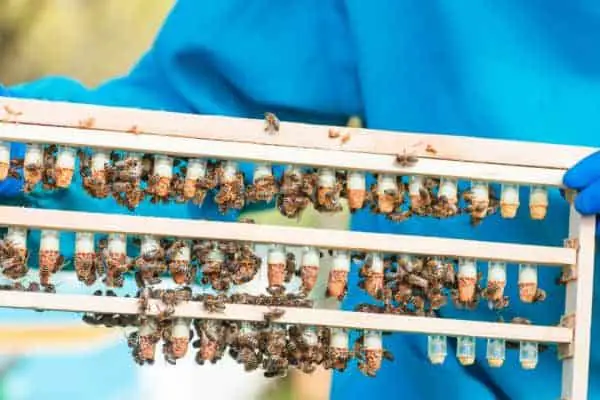
The queenless hive will quickly build queen cells around the eggs in the queen cups feeding the larvae royal jelly in order to grow new queens. The bee’s intent is to make queens in order to have one for their own colony. The beekeeper’s intent is to keep this hive in a state where they are desperately building queen cells so they can be harvested and incubated until they are ready to emerge from their wax queen cell.
This is not something the typical backyard beekeeper would undertake. Having said that, the genetics involved with breeding queen bees that produce strong and resilient hives is very interesting.
Queen rearing, using the Doolittle method, involves isolating the queen larvae. To do this, beekeepers take the fresh larvae—less than 24 hours old—and put them into a separate colony that doesn’t have a queen. Thus, the worker bees feed the eggs with royal jelly.
After ten days, the beekeeper transfers the queen eggs to an isolated mating colony. The queen hatches inside the mating colonies and stays there until she’s ready to mate. After doing the mating flights, she mates with several drones, fills her sperm reservoir giving her the potential to produce fertilized eggs for up to 5 years.
After successfully mating she returns to her hive where she typically begins laying within a few days.
A second method called the walk-away split involves splitting a hive into two colonies. One of them keeps the queen, and the other is left queenless. The beekeeper will leave a frame with fresh eggs. The worker bees within 24 hours will start making emergency cells to raise a queen quickly.
The queenless split needs to be monitored closely by the beekeeper because if their queen cells are unsuccessful the hive will die out without further intervention from the beekeeper.
The Wrap Up
Beehives can have more than one queen. But this happens under exceptional conditions and for a limited period. Established queen bees will either bee superseeded, being killed by the worker bees or alternatively the hive may swarm. Typically with the older queen leaving the hive with a significant number of worker bees.
Established queens bees will also kill unhatched rivals by stinging them inside the cells. If a new queen hatches while the previous queen is still alive, the two may fight each other to the death.
So, for the most part, there is only one queen bee in a beehive with a short period of time where there may be two or more queens however this is quickly resolved as we have outlined and the hive will return to just one queen.
Sources
- Bee Health: How are queen bees raised and mated?
- Thought co: The Roles of Queens, Drones, and Worker Honey Bees
- Npr.org: Nature’s Secret: Why Honey Bees Are Better Politicians Than Humans
- Bee culture: THE HORIZONTAL TWO-QUEEN SYSTEM
- The Conversation.com: A game of drones: why some bees kill their queens
- Earth Sky: How does a bee colony replace its queen?
- Dummies: Understanding the Role of the Queen Bee in a Hive
